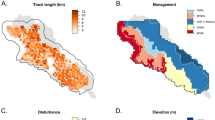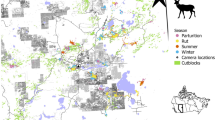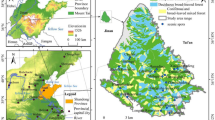Abstract
Background/Questions/Methods
White-tailed deer (Odocoileus virginianus) are a ‘keystone herbivore’ with the potential to cause tree regeneration failure and greatly affect vegetation dynamics, stand structure and ecological function of forests across eastern North America. In northern mixed conifer-hardwood forests, local winter-time deer populations are dependent on habitat characterized by patterns of forest cover that provide shelter from snow and cold temperatures (lowland conifer stands) in close proximity to winter food (deciduous hardwood stands). Stand structure may also influence winter spatial deer distribution. Consequently, modification of forest cover patterns and stand structure by timber harvesting will affect local spatial deer distributions, with potential ecological and economic consequences. Here, we ask if forest cover pattern and stand structure, and their interactions with snow depth, can explain winter deer density in the managed forests of the central Upper Peninsula of Michigan, USA. For each local winter deer density estimate (from fecal pellet counts) we calculate stand-level characteristics for surrounding ‘landscapes of influence’ of radius 200 m. For these data, and modeled snow depth estimates, we use multivariate techniques to produce predictive models and to identify the most important factors driving local deer densities across our 400,000 ha study area.
Results/Conclusions
Distance to the nearest conifer stand consistently explains the most variance in univariate regression models. Deer densities are highest near lowland conifer stands in areas where mean hardwood tree diameter-at-breast-height is low. Multiple regression models including these factors explain 22% of variance in deer density and have up to a 65% chance of correctly ranking a site’s deer density (relative to other sites within our study area). We use model ensembles to produce maps of estimated deer density (and associated uncertainty) for a subset of our study area and show how managers might use these maps to aid co-management of deer and forest regeneration. Our results highlight the importance of local and regional factors (forest cover-type pattern, stand structure, climate) on winter white-tailed deer density in managed hardwood-conifer forests. Use of these results, and the simulation model being developed, will help identify management practices that can decrease deer impacts and ensure the ecological and economic sustainability of forests in which deer browse is proving problematic for tree regeneration.
Similar content being viewed by others
Article PDF
Author information
Authors and Affiliations
Corresponding author
Rights and permissions
About this article
Cite this article
Millington, J., Walters, M., Matonis, M. et al. Local winter deer density: Effects of forest structure and snow in a managed forest landscape. Nat Prec (2009). https://doi.org/10.1038/npre.2009.3666.1
Received:
Accepted:
Published:
DOI: https://doi.org/10.1038/npre.2009.3666.1



